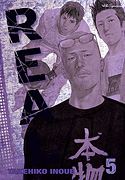Welcome to another new, hopefully semi-regular feature where I hope to highlight some really good comics that you probably aren’t reading. Let’s start with Takehiko Inoue’s Real (Viz). As I see it, there are two main reasons Real might not have found the audience it deserves.
 The first may be the fact that Real is perceived as sports manga, which seems to be right up there with josei in terms of stateside salability. Sports manga partisans are devoted, but they are not numerous. Now, I have a theory as to why this category might be significantly less popular in the United States than it is in Japan. It involves a fair amount of stereotyping, so I apologize in advance if this reasoning doesn’t apply to you, and I acknowledge that there will certainly be exceptions, possibly numerous.
The first may be the fact that Real is perceived as sports manga, which seems to be right up there with josei in terms of stateside salability. Sports manga partisans are devoted, but they are not numerous. Now, I have a theory as to why this category might be significantly less popular in the United States than it is in Japan. It involves a fair amount of stereotyping, so I apologize in advance if this reasoning doesn’t apply to you, and I acknowledge that there will certainly be exceptions, possibly numerous.
Now, we all know that a much larger percentage of Japanese kids read comics than kids in the United States do. It’s a much more normalized activity for kids there. And, in my experience, comics are one of the things American kids enjoy instead of sports. With a much larger population of comics-reading kids in Japan, it seems much more likely that a healthy percentage of them enjoy comics in addition to sports and consequently enjoy seeing one of their hobbies dramatized in that format. Speaking only for myself, I already feel like competitive athletics are sufficiently glamorized in more than enough venues, so I would much prefer if they kept their muddy cleat prints off of my comics, thank you very much.
 But Real isn’t actually a sports manga. It’s a character-driven drama. There’s certainly athletic activity being portrayed, and some characters are motivated by their desire to excel in competitive sports, but that’s really just one color in the book’s spectrum of aspirations. It’s much more about achieving independence and respect, which are much more universal.
But Real isn’t actually a sports manga. It’s a character-driven drama. There’s certainly athletic activity being portrayed, and some characters are motivated by their desire to excel in competitive sports, but that’s really just one color in the book’s spectrum of aspirations. It’s much more about achieving independence and respect, which are much more universal.
This brings me to the second possible hurdle to wanting to read Real: the fact that most of its protagonists are coping with a disability. Works that dramatize the experience of overcoming a disability struggle with some unfortunate (and often accurate) preconceptions: that they are mawkish in their attempts to uplift or self-righteous in their attempts to educate.
 Real suffers from neither of those failings. It’s gritty and funny and, as I noted before, driven by complex characters. There are no plaster saints in Inoue’s cast. That’s not to say that they’re unsympathetic, and I think the fact that they can be obnoxious or alienating makes the audience’s sympathetic reaction more genuine. Their flaws negate the potentially queasy feeling of abstract pity in favor of actual identification.
Real suffers from neither of those failings. It’s gritty and funny and, as I noted before, driven by complex characters. There are no plaster saints in Inoue’s cast. That’s not to say that they’re unsympathetic, and I think the fact that they can be obnoxious or alienating makes the audience’s sympathetic reaction more genuine. Their flaws negate the potentially queasy feeling of abstract pity in favor of actual identification.
Real is also magnificently drawn, as I’ve noted previously. That never hurts, especially when an artist folds as much emotion and subtext into his or her illustrations as Inoue does here. So, honestly, if you’re avoiding Real because it’s about sports or because you fear movie-of-the-week moralizing about the resilient disabled, I can assure you that you’ve nothing to fear. It’s a great comic with engrossing characters, and it deserves a larger readership. Five volumes are currently available in English, so you aren’t even really that far behind, as these things go.
(Got a book you feel deserves some audience development? Like to write a guest column about it? E-mail me and we’ll see what we can do.)
